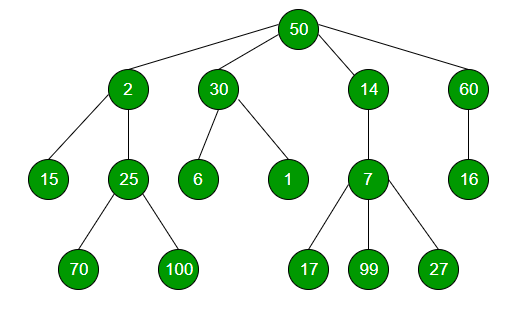n 叉树中给定节点的兄弟节点数
给定一棵 N 叉树,找出给定节点 x 的兄弟节点数。假设 x 存在于给定的 n 叉树中。

如果您希望与专家一起参加现场课程,请参阅DSA 现场工作专业课程和学生竞争性编程现场课程。
例子 :
Input : 30
Output : 3方法:对于给定的 n 叉树中的每个节点,将当前节点的子节点推送到队列中。在队列中添加当前节点的孩子时,检查是否有孩子等于给定的值 x。如果是,则返回 x 的兄弟姐妹数。
下面是上述想法的实现:
C++
// C++ program to find number
// of siblings of a given node
#include
using namespace std;
// Represents a node of an n-ary tree
class Node {
public:
int key;
vector child;
Node(int data)
{
key = data;
}
};
// Function to calculate number
// of siblings of a given node
int numberOfSiblings(Node* root, int x)
{
if (root == NULL)
return 0;
// Creating a queue and
// pushing the root
queue q;
q.push(root);
while (!q.empty()) {
// Dequeue an item from queue and
// check if it is equal to x If YES,
// then return number of children
Node* p = q.front();
q.pop();
// Enqueue all children of
// the dequeued item
for (int i = 0; i < p->child.size(); i++) {
// If the value of children
// is equal to x, then return
// the number of siblings
if (p->child[i]->key == x)
return p->child.size() - 1;
q.push(p->child[i]);
}
}
}
// Driver program
int main()
{
// Creating a generic tree as shown in above figure
Node* root = new Node(50);
(root->child).push_back(new Node(2));
(root->child).push_back(new Node(30));
(root->child).push_back(new Node(14));
(root->child).push_back(new Node(60));
(root->child[0]->child).push_back(new Node(15));
(root->child[0]->child).push_back(new Node(25));
(root->child[0]->child[1]->child).push_back(new Node(70));
(root->child[0]->child[1]->child).push_back(new Node(100));
(root->child[1]->child).push_back(new Node(6));
(root->child[1]->child).push_back(new Node(1));
(root->child[2]->child).push_back(new Node(7));
(root->child[2]->child[0]->child).push_back(new Node(17));
(root->child[2]->child[0]->child).push_back(new Node(99));
(root->child[2]->child[0]->child).push_back(new Node(27));
(root->child[3]->child).push_back(new Node(16));
// Node whose number of
// siblings is to be calculated
int x = 100;
// Function calling
cout << numberOfSiblings(root, x) << endl;
return 0;
} Java
// Java program to find number
// of siblings of a given node
import java.util.*;
class GFG
{
// Represents a node of an n-ary tree
static class Node
{
int key;
Vector child;
Node(int data)
{
key = data;
child = new Vector();
}
};
// Function to calculate number
// of siblings of a given node
static int numberOfSiblings(Node root, int x)
{
if (root == null)
return 0;
// Creating a queue and
// pushing the root
Queue q = new LinkedList<>();
q.add(root);
while (q.size() > 0)
{
// Dequeue an item from queue and
// check if it is equal to x If YES,
// then return number of children
Node p = q.peek();
q.remove();
// Enqueue all children of
// the dequeued item
for (int i = 0; i < p.child.size(); i++)
{
// If the value of children
// is equal to x, then return
// the number of siblings
if (p.child.get(i).key == x)
return p.child.size() - 1;
q.add(p.child.get(i));
}
}
return -1;
}
// Driver code
public static void main(String args[])
{
// Creating a generic tree as shown in above figure
Node root = new Node(50);
(root.child).add(new Node(2));
(root.child).add(new Node(30));
(root.child).add(new Node(14));
(root.child).add(new Node(60));
(root.child.get(0).child).add(new Node(15));
(root.child.get(0).child).add(new Node(25));
(root.child.get(0).child.get(1).child).add(new Node(70));
(root.child.get(0).child.get(1).child).add(new Node(100));
(root.child.get(1).child).add(new Node(6));
(root.child.get(1).child).add(new Node(1));
(root.child.get(2).child).add(new Node(7));
(root.child.get(2).child.get(0).child).add(new Node(17));
(root.child.get(2).child.get(0).child).add(new Node(99));
(root.child.get(2).child.get(0).child).add(new Node(27));
(root.child.get(3).child).add(new Node(16));
// Node whose number of
// siblings is to be calculated
int x = 100;
// Function calling
System.out.println( numberOfSiblings(root, x) );
}
}
// This code is contributed by Arnab Kundu Python3
# Python3 program to find number
# of siblings of a given node
from queue import Queue
# Represents a node of an n-ary tree
class newNode:
def __init__(self,data):
self.child = []
self.key = data
# Function to calculate number
# of siblings of a given node
def numberOfSiblings(root, x):
if (root == None):
return 0
# Creating a queue and
# pushing the root
q = Queue()
q.put(root)
while (not q.empty()):
# Dequeue an item from queue and
# check if it is equal to x If YES,
# then return number of children
p = q.queue[0]
q.get()
# Enqueue all children of
# the dequeued item
for i in range(len(p.child)):
# If the value of children
# is equal to x, then return
# the number of siblings
if (p.child[i].key == x):
return len(p.child) - 1
q.put(p.child[i])
# Driver Code
if __name__ == '__main__':
# Creating a generic tree as
# shown in above figure
root = newNode(50)
(root.child).append(newNode(2))
(root.child).append(newNode(30))
(root.child).append(newNode(14))
(root.child).append(newNode(60))
(root.child[0].child).append(newNode(15))
(root.child[0].child).append(newNode(25))
(root.child[0].child[1].child).append(newNode(70))
(root.child[0].child[1].child).append(newNode(100))
(root.child[1].child).append(newNode(6))
(root.child[1].child).append(newNode(1))
(root.child[2].child).append(newNode(7))
(root.child[2].child[0].child).append(newNode(17))
(root.child[2].child[0].child).append(newNode(99))
(root.child[2].child[0].child).append(newNode(27))
(root.child[3].child).append(newNode(16))
# Node whose number of
# siblings is to be calculated
x = 100
# Function calling
print(numberOfSiblings(root, x))
# This code is contributed by PranchalKC#
// C# program to find number
// of siblings of a given node
using System;
using System.Collections.Generic;
class GFG
{
// Represents a node of an n-ary tree
public class Node
{
public int key;
public List child;
public Node(int data)
{
key = data;
child = new List();
}
};
// Function to calculate number
// of siblings of a given node
static int numberOfSiblings(Node root, int x)
{
if (root == null)
return 0;
// Creating a queue and
// pushing the root
Queue q = new Queue();
q.Enqueue(root);
while (q.Count > 0)
{
// Dequeue an item from queue and
// check if it is equal to x If YES,
// then return number of children
Node p = q.Peek();
q.Dequeue();
// Enqueue all children of
// the dequeued item
for (int i = 0; i < p.child.Count; i++)
{
// If the value of children
// is equal to x, then return
// the number of siblings
if (p.child[i].key == x)
return p.child.Count - 1;
q.Enqueue(p.child[i]);
}
}
return -1;
}
// Driver code
public static void Main(String []args)
{
// Creating a generic tree
// as shown in above figure
Node root = new Node(50);
(root.child).Add(new Node(2));
(root.child).Add(new Node(30));
(root.child).Add(new Node(14));
(root.child).Add(new Node(60));
(root.child[0].child).Add(new Node(15));
(root.child[0].child).Add(new Node(25));
(root.child[0].child[1].child).Add(new Node(70));
(root.child[0].child[1].child).Add(new Node(100));
(root.child[1].child).Add(new Node(6));
(root.child[1].child).Add(new Node(1));
(root.child[2].child).Add(new Node(7));
(root.child[2].child[0].child).Add(new Node(17));
(root.child[2].child[0].child).Add(new Node(99));
(root.child[2].child[0].child).Add(new Node(27));
(root.child[3].child).Add(new Node(16));
// Node whose number of
// siblings is to be calculated
int x = 100;
// Function calling
Console.WriteLine( numberOfSiblings(root, x));
}
}
// This code is contributed by PrinciRaj1992 Javascript
输出:
1时间复杂度: O(N),其中 N 是树中的节点数。
辅助空间: O(N),其中 N 是树中的节点数。